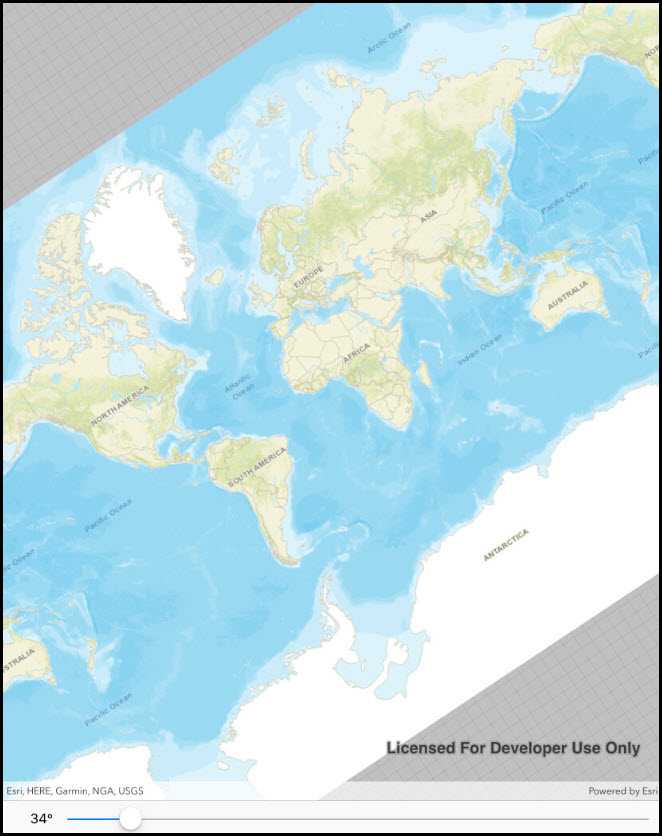Rotate a map.

Use case
A user may wish to view the map in an orientation other than north-facing.
How to use the sample
Use the slider to rotate the map.
How it works
- Instantiate an
Mapobject. - Set the map in the
MapViewobject. - Use
SetViewpointRotationAsyncto indicate the rotation angle.
Relevant API
- Map
- Compass
- MapView
Tags
rotate, rotation, viewpoint
Sample Code
MapRotation.cs
// Copyright 2016 Esri.
//
// Licensed under the Apache License, Version 2.0 (the "License"); you may not use this file except in compliance with the License.
// You may obtain a copy of the License at: http://www.apache.org/licenses/LICENSE-2.0
//
// Unless required by applicable law or agreed to in writing, software distributed under the License is distributed on an
// "AS IS" BASIS, WITHOUT WARRANTIES OR CONDITIONS OF ANY KIND, either express or implied. See the License for the specific
// language governing permissions and limitations under the License.
using System;
using Esri.ArcGISRuntime.Mapping;
using Esri.ArcGISRuntime.UI.Controls;
using Foundation;
using UIKit;
namespace ArcGISRuntime.Samples.MapRotation
{
[Register("MapRotation")]
[ArcGISRuntime.Samples.Shared.Attributes.Sample(
name: "Map rotation",
category: "MapView",
description: "Rotate a map.",
instructions: "Use the slider to rotate the map.",
tags: new[] { "rotate", "rotation", "viewpoint" })]
public class MapRotation : UIViewController
{
// Hold references to UI controls.
private MapView _myMapView;
private UILabel _rotationLabel;
private UISlider _rotationSlider;
public MapRotation()
{
Title = "Map rotation";
}
private void Initialize()
{
// Show a streets basemap.
_myMapView.Map = new Map(BasemapStyle.ArcGISStreets);
}
private void RotationSlider_Changed(object sender, EventArgs e)
{
_myMapView.SetViewpointRotationAsync(_rotationSlider.Value);
_rotationLabel.Text = $"{_rotationSlider.Value:0}\u00B0";
}
public override void ViewDidLoad()
{
base.ViewDidLoad();
Initialize();
}
public override void LoadView()
{
// Create the views.
View = new UIView {BackgroundColor = ApplicationTheme.BackgroundColor};
_myMapView = new MapView();
_myMapView.TranslatesAutoresizingMaskIntoConstraints = false;
_rotationSlider = new UISlider
{
MinValue = 0,
MaxValue = 360,
TranslatesAutoresizingMaskIntoConstraints = false
};
_rotationLabel = new UILabel
{
Text = "0\u00B0",
TextAlignment = UITextAlignment.Center,
TranslatesAutoresizingMaskIntoConstraints = false
};
UIToolbar toolbar = new UIToolbar();
toolbar.TranslatesAutoresizingMaskIntoConstraints = false;
toolbar.Items = new[]
{
new UIBarButtonItem(_rotationLabel),
new UIBarButtonItem(UIBarButtonSystemItem.FixedSpace) {Width = 0},
new UIBarButtonItem(_rotationSlider)
};
// Add the views.
View.AddSubviews(_myMapView, toolbar);
// Lay out the views.
NSLayoutConstraint.ActivateConstraints(new[]
{
_rotationLabel.WidthAnchor.ConstraintEqualTo(64),
_myMapView.TopAnchor.ConstraintEqualTo(View.SafeAreaLayoutGuide.TopAnchor),
_myMapView.LeadingAnchor.ConstraintEqualTo(View.LeadingAnchor),
_myMapView.TrailingAnchor.ConstraintEqualTo(View.TrailingAnchor),
_myMapView.BottomAnchor.ConstraintEqualTo(toolbar.TopAnchor),
toolbar.LeadingAnchor.ConstraintEqualTo(View.LeadingAnchor),
toolbar.TrailingAnchor.ConstraintEqualTo(View.TrailingAnchor),
toolbar.BottomAnchor.ConstraintEqualTo(View.SafeAreaLayoutGuide.BottomAnchor)
});
}
public override void ViewWillAppear(bool animated)
{
base.ViewWillAppear(animated);
// Subscribe to events.
_rotationSlider.ValueChanged += RotationSlider_Changed;
}
public override void ViewDidDisappear(bool animated)
{
base.ViewDidDisappear(animated);
// Unsubscribe from events, per best practice.
_rotationSlider.ValueChanged -= RotationSlider_Changed;
}
}
}